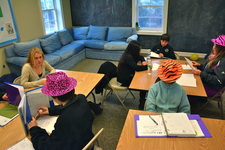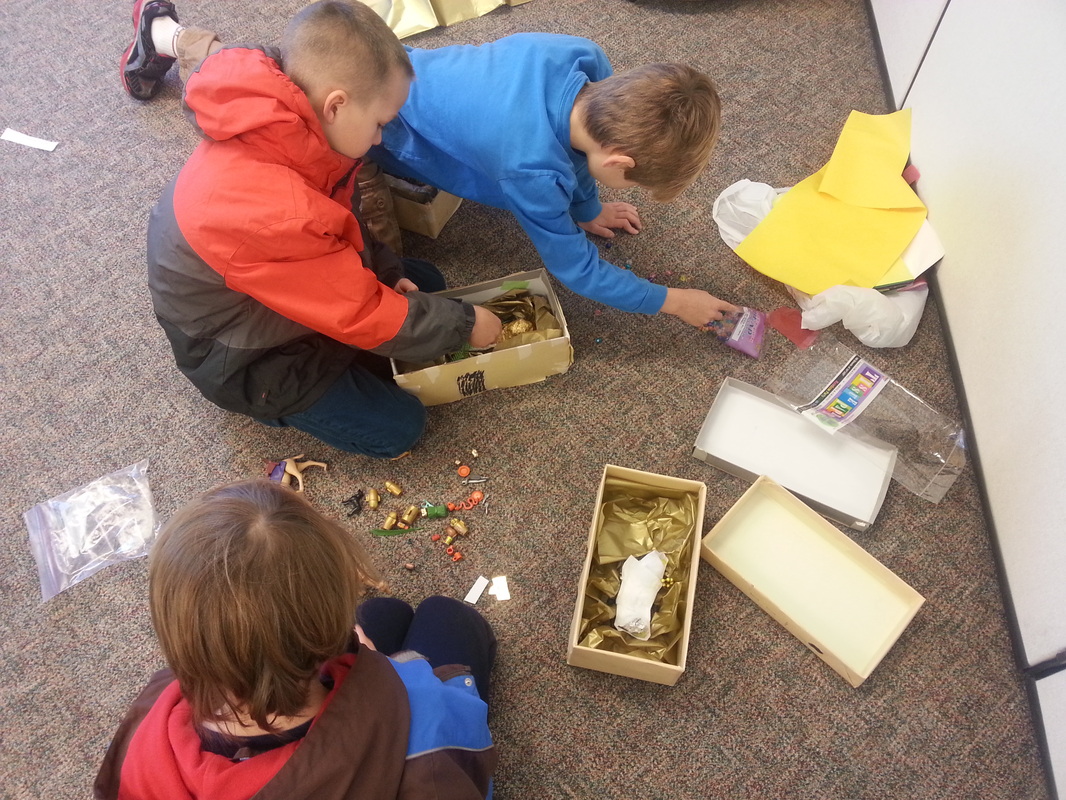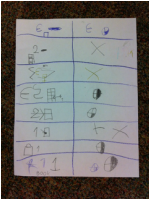SarcophagiStudents completed the outside of their sarcophagi in our morning class, adding the "egyptian eye" symbol and a door for their mummy's Ba to come and go. Writing Games
You might enjoy playing this as a family at home. It's not as easy as you think! Playing with Measurements To think further about measurement we began our afternoon class by reading Is the blue whale the biggest thing there is? This book encouraged us to think about size creatively. Next we made a list of ten things that we would each measure with our own cubit. Then we set to work, recording our measurements on a chart. When we were done we found that we had different measurements for some things, especially the length of the room. This led to some interesting observations about the importance of using the same unit of measure. We wonder whether the Ancient Egyptians had any problems using digits, palms, and cubits to measure things? Foundations of Philosophy (ages 9-11) |
Hour of CodeA few of our Mosaic students (in two states!) participated in Computer Science Education week (December 9-15), by completing the Hour of Code challenge. Students learned basic code by creating original holiday "cards." Nice work, everyone! We wish all of our families a safe and wonderful holiday season! As a reminder, classes will resume on Monday, January 6, 2014. Best Wishes, Jayne & Angela |
Introducing the Airhead 2000!
 {Homework Solution} Airhead 2000 finite state diagram
{Homework Solution} Airhead 2000 finite state diagram First, we tackled the Airhead 2000 homework by drawing out the FSM together. Some of the students struggled with the homework, but I believe most understood after we reviewed.
Next, I pushed the students beyond their comfort level by illustrating two FSM’s. One was used to add two binary numbers, and the other was a parity checker. The purpose was to cycle back on topics we covered in the beginning of the semester, but now focusing on how the computer is actually instructed by the programmer.
After those mind-boggling examples, we took a break by officially defining an FSM and went on a virtual treasure hunt. The students were pirates and had to take imaginary boats between islands. They were successful when they found the shortest route to Treasure Island. When the students completed the activity they realized they had created another FSM.
With a firm understanding of FSM’s we discussed their applications in Computer Science, specifically in the following areas: the lexical analysis part of the compiler, text editing, computer networks, and string searching within a word processor.
Finally, we had a brief discussion on artificial intelligence and how a computer can appear to understand and respond appropriately. Think Siri.
We covered a lot of material! The students should be proud of themselves. Grasping the concept of an FSM at such a young age is truly an achievement!
I wish all of my students and their families a blessed holiday.
Holiday Fun

First, riffing off The Nightmare Before Christmas, everyone was given a Christmas character – from well-known ones such as Santa Class to less-known (and frankly imaginary) ones, such as the Candy Cane Kid and Lenny the List Maker.
Then we combined them with other holiday characters, such as the Easter Bunny or the Valley Girl Valentine.
While almost no one finished their stories, we had some great starts. I hope some of the kids will finish these off over the break – but they don’t have to.

Journal Submissions and End-of-Session Readings
In addition, they should decide what they want to read for our end-of-session reading. Rules: up to four double-spaced pages or three poems. It does not need to be what they submitted to the journal, although it can be.
And please do let me know if you plan to attend the reading – family welcome!

Happy holidays, everyone!
December 2
 Iron Hearted Violet
Iron Hearted Violet The adventures the Little Prince had as he traveled from planet to planet raised interesting questions, especially about authority and ownership. The king says he rules over everything, but does he have any real authority? What is real authority? Where does it come from? We talked about authority in the contexts the students are most familiar with: a parent's authority, teacher's authority, and coach's authority. Our philosophy students determined that authority can come from the responsibility to take care of someone, or by voting, or through force.
The businessman says that the stars belong to him. In class, we began a chart comparing and contrasting the authority and ownership of the king and the businessman with that of the Little Prince. In two weeks, we will begin discussing our final book for the course, Iron Hearted Violet. This is a long book. I highly recommend it as a family read-aloud, or even on audio, for students who may find the book challenging. As we have done all semester, we will begin class each week by working on a simple story map to make sure that we all understand the reading before we begin our discussions.
December 9
 From "The Little Prince"
From "The Little Prince" We connected this to the story of the Little Prince. One student suggested that it was as if the flower had authority over the prince, even though the prince took care of the flower.
In Chapter 20 (XX), the Little Prince encounters a flower just like his. The Little Prince says, “I thought I was rich…; and all I had was a common rose.”
We considered the relationship between beauty and friendship. Can we find someone or something more or less beautiful if we know them better? What is the relationship between friendship and responsibility? We will continue to explore the themes of beauty, authority, and friendship as we read Iron Hearted Violet.
In class I asked students to read the first five chapters of Iron Hearted Violet for next week, and then write a paragraph or more answering the following question: How does the friendship between Violet and Demetrius compare to your criteria for friendship?
Have a great week!
Area and Perimeter

On Monday we talked about using algebra in the real world. Many students had thought about it during the week. One even had a list of professions which use algebra that was a page long!
Professor Arbegla had been talking about this topic with her students in the college class she teaches, when she realized that algebra was used when she remodeled her bathroom. She was planning on tiling the bathroom floor. She knew the dimensions of the floor (6’ x 7’) and was ready to pick out tiles. Since they were so expensive, she wanted to have an idea of how many tiles she should purchase before going to the store. That’s where our class came in. Each tile was one foot square. The students spent some time figuring out how she could know how many to buy. Some drew pictures. Some knew intuitively that multiplying the number of rows by the number of columns would give us the number of tiles. We discussed why multiplying works and how finding the area of the room could help her with her project. We assigned the letter “l” for length and “w” for width and came up with a rule for area to put on our toolkit.


- The students were then challenged to write as many equations as they could where the dimensions of the room equaled an area of 36 square feet. Those who finished early were further challenged to come up with dimensions of the room that weren’t whole numbers! After coming up and sharing nine possible equations using whole numbers, they mapped each one out on graph paper. In the midst of this, it came up that each room had a “partner” room, or a room which had the same dimensions but switched as to the length and width, except for a room with the dimensions of 6’ x 6’. We talked about the area of the partner rooms and if they were the same or not. Shapes with the same size and shape are called congruent shapes, which led us into discussing the commutative property of multiplication:
- a x b = b x a which we recorded on our toolkit as well.
Next week we continue discussing area and planning spaces to be used for particular purposes. How does its purpose affect how we lay out the area of the enclosure? What’s the best set up for the enclosure? Some students were interested in pursuing the area of triangles and circles, so they decided to look into that for homework to share with the class next week. I look forward to letting them teach the class a thing or two!
Ka and Ba

I asked the students to take a few minutes and think about what makes them unique. What qualities define who you are? We discussed whether or not there is anyone else in the world exactly like them. I then asked them to write a word, a sentence, or a list to express who they are. Many students began by giving physical characteristics - hair color, age, gender. Then they moved on to listing what they like (cats, dogs, food) or like to do (play soccer, baseball, run, camp). We dug a little deeper when I asked them if they thought what they looked like or what they did is really who they are. Hmmm... a deep philosophical question even for adults! We took some of the examples of what they like to do (play the violin) and turned them in to qualities about ourselves (I am musical). Suddenly, many more qualities came to mind (sporty, playful, kind, curious, helpful, funny, awesome!).
Wrapping up Mummy

Next week we will add hieroglyphics, images of gods and goddesses, egyptian eyes, and any other decorations the students would like.
Homework!

Word search: Last call for any student that wants to complete the word search and bring it to class for a small prize. Here is the file to download and print in case you did not pick one up in class.
Enjoy the snow! See you all next week!
Measuring Like Ancient Egyptians

The ancient Egyptian cubit was a measurement based on the distance from the Pharoah's elbow to his fingertips.
Message Routing and Third Unit {Representing Procedures}

Next, we began our third unit, Telling Computers What to Do – Representing Procedures. Now that we have a solid understanding of algorithms and can even put them into words, we will focus on giving the right instructions to the computers. The students will shortly discover that it is not as easy as it sounds!
Finite State Machine
This concept is one that is taught in college level courses and sometimes not until graduate level. Hopefully, by using a variety of hands-on activities and instruction all the students will acquire a general understanding. We will continue this topic for at least one more class.
Categories
All
Afternoon Enrichment
Closures
Clubs
Early Elementary
Mosaic Texas
Odyssey Of The Mind
Out Of This World
Philosophy
Tesserae Fall 2012
Tesserae Fall 2013
Tesserae Fall 2014
Tesserae Spring 2013
Tesserae Spring 2014
Tesserae Spring 2015
Tesserae Spring 2016
Archives
May 2016
April 2016
March 2016
February 2016
June 2015
May 2015
April 2015
March 2015
February 2015
January 2015
December 2014
November 2014
October 2014
September 2014
July 2014
June 2014
May 2014
April 2014
March 2014
February 2014
January 2014
December 2013
November 2013
October 2013
September 2013
July 2013
May 2013
April 2013
March 2013
February 2013
January 2013
December 2012
November 2012
October 2012
September 2012
August 2012


































 RSS Feed
RSS Feed